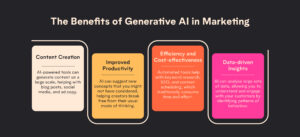If you’re new to generative AI in marketing, or you’re wondering what all the fuss is about, then this blog post is for you.
Marketers always have lots of different tasks to juggle whether that’s creating new content, analysing data and analytics, or crafting campaigns to better connect with their audience, the job of a marketer is vast.
Generative AI can help with all of these things by using advanced machine learning algorithms which use vast amounts of data to produce human-like text, generate images, and even create videos.
Lots of companies recognise the importance and benefits of using generative AI to support their teams and increase the efficiency and quality of their output. But it’s not all about the tech – your team needs to understand how to use it to their advantage, striking the right balance between AI generated content and human-generated content.
In this blog, we’re going to be exploring the importance of AI alongside benefits and strategies you can use to leverage this tool for success.










